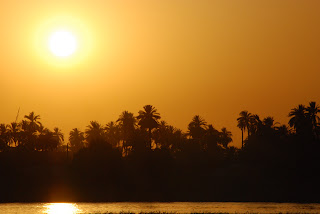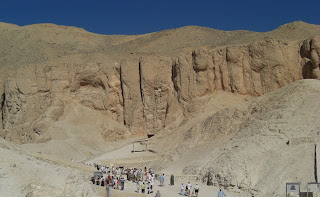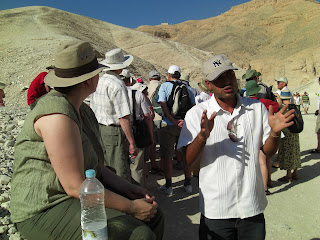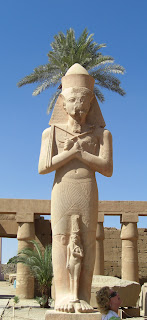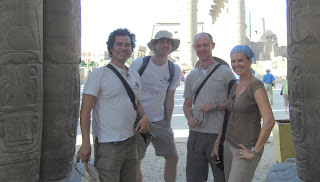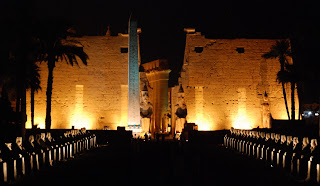Relaxing like Pharaohs on the Nile
The Nile by felucca
One of the experiences that we were really looking forward to in Egypt was taking a felucca down the Nile. A felucca is a traditional wooden sailing boat that was used in protected waters of the Red Sea and the Mediterranean. It was meant to be an amazing experience to just float down the Nile for 2 days, so we signed right up.
Feluccas sailing down the Nile
Before we knew it, we were climbing onboard a felucca with two 14 year old boys. Were these our captains? Obviously the answer to that was yes, but it's still a little crazy. But either way. we were off-- sailing down the Nile.
Kyle hanging out on the felucca after a little swim.

A local boy bathing his donkey in the river... (and we wondered why you can get so many diseases from being in it??)

More locals

Our first meal on the boat... we were still smiling at this point as we thought it was for 2 of us, not 5.
10 year old Twinkies -- what we ate when we didn't have enough food for meals
Karkaday, a juice made from hibiscus flowers -- what we drank when we ran out of water... Well, that's not completely true. We also managed to drink about 16 beers between us as well.
Contemplating whether to jump in the surprisingly chilly water

Resting after enjoying a refreshing swim

And walking back around to jump in for another swim.


A few local boys swam out to our boat to say hello

Our new friends Tickle, Graham, and Dawn demonstrating what we did with the rest of the day when we weren't swimming.... a whole lot of nothing.
Schistosomiasis, or bilharzia, is a parasitic disease caused by trematode flatworms. Larvae from snails are released into the water and penetrate the skin of people in the water.
In the body, the larvae mature. living in the blood vessels. The females release eggs, some of which are passed out of the body in the urine or faeces while others are trapped in body tissues, causing an immune reaction.
The potential complications are progressive damage to the bladder, ureters and kidneys as well as progressive enlargement of the liver and spleen, intestinal damage, and hypertension of the abdominal blood vessels.
Fabulous. That sounds great, huh? Well, I've probably already got the worms so I'd better start investigating the treatment plan... Clare, where can we get the drugs to kill the scary Nile worms??
"Yeah, I've got worms, I'm sure, but I'm way too hot to care."
One of the other highlights of the boat ride was the lack of a toilet. Now for the boys, this wasn't that much of a problem, but it's a teensy bit more complicated for girls. When we anchored offshore both nights, it became a fun experiment as we tested the flimsy canopy to see how much weight it would support as we hung our butts overboard to "use the facilities," ie the Nile. Neither myself nor Dawn fell in, but I was kind of expecting it to happen. (And of course, the boys were hoping for it to get a good laugh!)
One of the best parts of the trip was completely relaxing and just enjoying the scenery, especially the stunning sunsets.
A couple of feluccas connecting from one of the tributaries, but it looked strangely like they were sailing on the shore.
A couple feluccas sailing with the wind back upstream
"Yeah, we could be doing worse things at the moment..."
We also had a minor flub when our 14 year old captains, that didn't speak a word of English, pulled into a dock a 7pm on the second day and tried to make us get off. Now hold on, we signed up and paid for 2 nights, not just one! As much as we tried our skills at charades, it ended up requiring 3 different phone calls to our Aswan tour guide and the tour company manager. Straightened out in the end, but not the way it should have worked out.
Since we had already reached our intended destination early, there was no where to tie off except to a busy ferry dock next to the highway. Not the peaceful night's sleep that we were hoping for. They even tried to tie us onto the dock in a place that was very loud and right under street lights, therefore swarming with bugs. That led to the third phone call.
So, to wrap it up... a felucca down the Nile is definitely the complete Egyptian experience: fantastic sights, unforgettable scenery, tempered with good old fashioned incompetence.
Kom Ombo & Edfu
The next morning, after an iffy night's sleep, we had a 7am pickup from a tour guide who would be taking us around the sights of Kom Ombo, Edfu and dropping us in Luxor.
The ferry dock we tied up to for the night
Our first stop of the day was Kom Ombo Temple. Kom Ombo is a double temple built during the Ptolemic period that took nearly 400 years to complete.
Posing in front of the temple
Those Egyptians really knew how to do columns...
Dawn and Kyle struggling to position themselves to take in the amazing ceiling
While Dawn, our resident archaeologist, could tell us all about every God and the cool, twisted stories related to them, I can't remember them. But I have still included some of my favorite portraits of the Gods.
An example of the defacement made by the Christians to the "false idols"
Some of the beautiful detailing on the front of the temple
Edfu Temple
Edfu Temple is a Ptolemaic temple and the second largest temple in Egypt after Karnak Temple and built over 180 years (from 237 BC - 57BC). The most amazing thing about the Edfu temple is that it was buried under almost 12 meters of sand for centuries until the excavation began in 1860. Unlike many other temples that have had lots of restoration and vandalism done, this temple was remarkably well-preserved under the stand and ia the best preserved ancient temple in Egypt.

The front of the Temple of Horus (the falcon God)

A likeness of the God Horus in the middle

...and again on the right
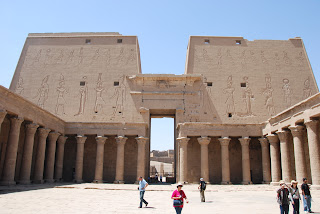
The Inner Courtyard
The huge columns in the inner courtyard

The dark lighting and stunning beams of sunlight gave the inner areas of this temple a different feel to others.
Enjoying exploring the dark, mysterious-feeling temple
The hieroglyphics that cover the walls
The carvings on the temple walls here were amazing and also the first that we were allowed to take photos of. This was the kind of thing that I was waiting to see!
A ceremonial barge tucked away in an alcove
Luxor

Ironic that these signs are everywhere as all you can hear is horn noise 24/7. (Not fond of following rules here...)
We called up Sam, the guy from our hotel in Cairo that had arranged our whole tour. He was shocked to hear about the felucca mishap and apologetic about our hotel issues. Based on our other experiences in Egypt & Morocco, we really didn't expect anything to change. But we were pleasantly surprised when Sam got on the horn with the owner of the tour company, Mustafa, who promptly called the hotel to speak to us. He was very apologetic, and insisted on upgrading us to a much nicer hotel to please us. Wow. This was our first experience with good customer service in Egypt. A refreshing surprise!
We happily checked into the Isis Hotel down the street, changed into our cossies and hit the pool. After lots of hostels and 2 nights sleeping on the deck of a boat, it felt really luxurious to sleep in a nice suite and lounge by a lovely pool. Add a couple cold beers and burgers, and we were in heaven.
The view of the Nile from our new hotel
The hotel had quite a selection of restaurants to choose from as well, and we ended up with a tasty Chinese meal. Not what you expect to eat in Luxor, but tasty and a great change of pace.
Now, the reason to go to Luxor is because it has some of the most amazing relics in Egypt, all in close proximity to the town.
- Valley of the Kings & Valley of the Queens (West Bank)
- Funerary Temple of Hatshepsut (West Bank)
- Medinut Habu (West Bank)
- Karnak Temple (East Bank)
- Luxor Temple (East Bank)
Valley of the Kings
The Valley of the Kings is the burial site for scores of pharaohs of Egypt from 16th-11th centuries BC. Unfortunately, in an effort to preserve the tombs, most of them are not open to the public.
With our entry ticket, we wre able to tour 3 tombs so we saw the tombs of Ramses I, Ramses III and Ramses IX. The tombs of Ramses VI & Tuthankaman (King Tut) are the most popular (commanding an extra entry fee), but since all the tombs have been emptied, there wasn't anything more to see there anyway.
A map of Ramses I's tomb
Our guide telling us about the tombs
The tombs were long, narrow passages dug deep into the ground containing the sarcophagus of the king or noble and rooms full of the items he would need for the afterlife. Of course, there are no jewels or other valuables in there now as most were looted over the centuries
Entering the tombs was very hot and humid. It wasn't nearly as tight as the tunnel down into the pyramids, so it wasn't claustrophobia-inducing. Many of the walls still had the original paintings and carvings on them. Unfortunately, as is often the case, we weren't allowed to take pictures in any of them.
Entering one of the tombs
Based on lackluster reviews, we decided to skip the Valley of the Queens and head to some more impressive temples instead.
Temple of Deir el Bahari (The Funerary Temple of Hatshepsut)
Much of the Temple of Hatshepsut had been destroyed as she wasn't exactly the most popular girl in school. As you do in those days, she married her half-brother (who became ruler), and when he died, by rights, her brother's son (by another wife) should have become pharaoh. However, she thought he was too young, so she took the title for herself going so far as representing herself as a man in person and in statues of herself. And then she suffered the consequences... She died a "death of unknown cause" and after her death, anything with her likeness on it has been defaced, literally trying to remove her face from history.
Kyle trying to look like he's enjoying himself despite the ridiculous heat.
Some of the wall carvings in their original form showing just how colourful they would have been. Call me crazy, but I think that I preferred the colourless ones.
Reconstructed statues of Hatshepsut as a male pharaoh
Since the day was absolutely smoking hot (well into the 40s), we were pretty keen to move into the shade. As luck would have it, our tour operator managed to finagle in a little side trip to an Alabaster shop (which he likely earns 40 percent commission on). Oh well, it's shade.
An artisan working on some alabaster products
Medinet Habu
The 63 meter long first pylon at the temple
Medinet Habu is the Mortuary Temple of Ramses III. (1184-1153 BC), and surrounded by a defensive wall 20 meters high and 12 meters thick. The most amazing part though is more 7000 square meters of wall reliefs (wall carvings). Amazing!!
A statue of the goddess Sekhmet
Photos don't really do justice to these reliefs. They were unbelievable and everywhere!




"Cartouches" of the Pharaoh's name are found all over the temples
It was hard to break ourselves away!Karnak
Ram-headed sphinxes lining the temple entry
Admiring the columns in the Hypostyle Hall
Amazing statue of Ramses II
There are 2 amazing obelisks remaining in Karnak. Second only to the obelisk in Rome, the obelisk erected by Queen Hatshepshut (daughter of Tuthmosis) is 29 meters high and weighs 320 tons. Fortunately, it escaped defacement and was well preserved, having had a wall built around it that hid it from view of the people.
A second, smaller obelisk was erected by her son, Tuthmosis III. It stands 21 meters tall and weighs about 143 tons.
Tuthomosis's obelisk
More rams head sphinxes

Minh, the God of Fertility (on the right) -- apparently the Christians came along later and thought it was porn so they tried to destroy it. Yeah, you would never know what was there...

A column with a scarab (beetle) on top -- it is supposed to bring you long life and happiness to people that walk around it 7 times
An ancient Egyptian family portrait!
Luxor Temple
Luxor Temple was built around 1400BC and was built to be the center of festivities for the annual Opet Festival. The Opet Festival was a 27 day long event celebrating the Egyptians connection to the gods.
The entrance to the temple, showing the one remaining pink granite obelisk. (The other now stands in the center of the Place de la Concorde in Paris)


The collonnaded entry to the inner part of the temple
Another statue of Ramses II - Apparently, he was very fond of himself since there are statues of him at every temple we visited!
Prior to excavation, the muslims had built an mosque right on top of the site. They then refused to let the mosque be torn down, so it now teeters on top of part of the Luxor Temple
Early Christian paintings, done over the original hieroglyphics - these are archealogically significant in themselves!
We can never really have too many pictures of the beautiful reliefs...
and Dawn
And while we didn't actually get to visit the temple at night, the views of it from the main street were lovely.
After all those temples and a little history overload for me, we were pretty keen to get on our way to the Sinai Peninsula for some Red Sea diving. I bought the mandatory Egyptian souvenir (a cartouche with my name in hieroglyphs), and made our way to the overnight, sleeper train back to Cairo en route to Dahab.










